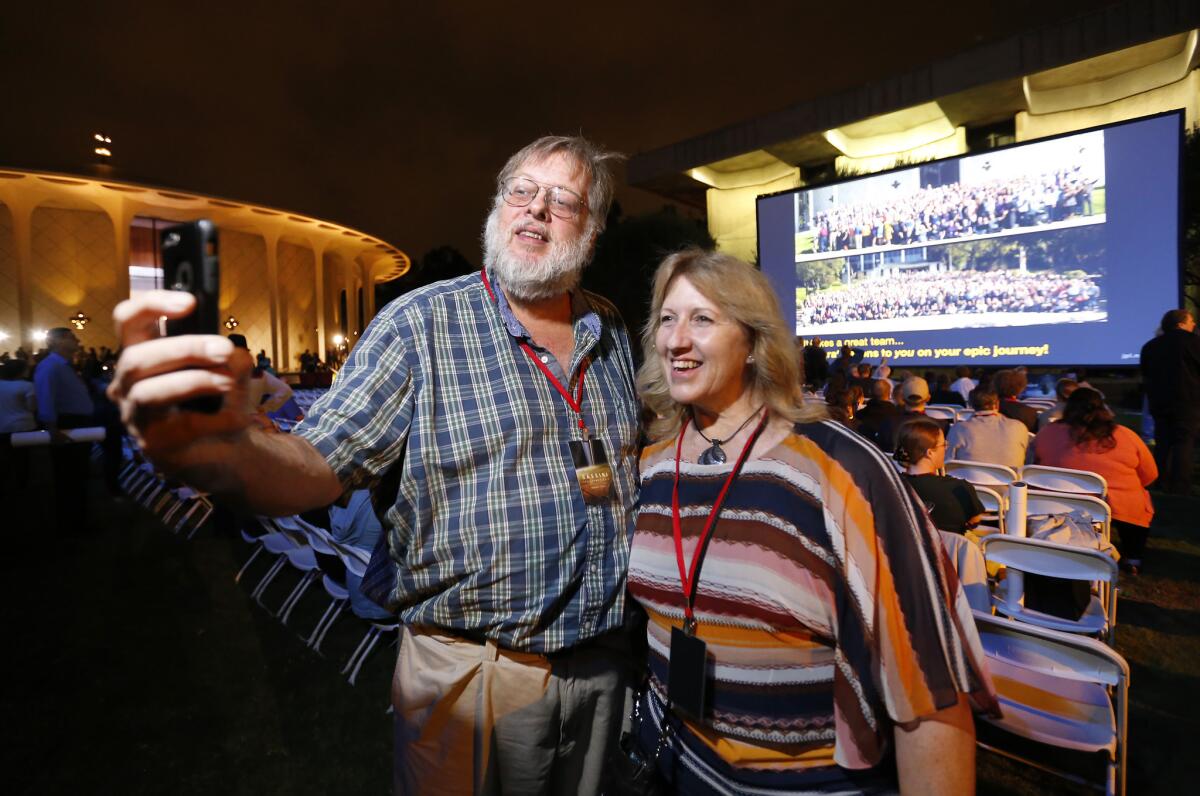Cassini scientists celebrate the mission’s end with a few hundred of their closest friends

NASA employees, friends and family attend a watch party at Caltech for Cassini’s final signal back to Earth.
- Share via
The sky was dark and cloudy, the temperature chilly, and the mood bittersweet as hundreds of scientists and their families gathered at
Full coverage of Cassini's Grand Finale »
There were rows upon rows of white chairs on the lawn outside the Beckman Auditorium, and a large crowd inside too.A live feed from the Jet Propulsion Laboratory was projected onto multiple screens, documenting the mission’s final moments. People held up their cellphones to record it.
There were hugs and tears. Researchers from around the world greeted colleagues they hadn’t seen in years. Young children napped in their seats, while their elders drank coffee — and champagne.
Growing up with Cassini
Peter Kollmann, 33, said he began the week excitedly anticipating Cassini’s final data. But as Friday drew near, his mood changed.
“I started being a scientist with Cassini,” said Kollman, who wrote his Ph.D. thesis on the spacecraft. He now works at the Johns Hopkins Applied Physics Laboratory in Laurel, Md., where his focus is a Cassini instrument that measures radiation belts.
“Knowing it will be over, it makes me sad,” he said. “But we’ll continue working with it because there’s still so much data.”
Carrie Nugent, 33, a self-described “asteroid hunter” and scientist at Caltech’s Infrared Processing and Analysis Center, worked on the spacecraft’s Composite Infrared Spectrometer while she was a graduate student at UCLA.
At 3:33 a.m., just after Cassini hurtled into the planet’s atmosphere but before JPL received its final signal, she said she was “wondering if it already died.”
“Personally, I’m pretty sad,” she said. “It’s a good little space robot, and I’ll miss it.”
John Barbara, 40, works on Cassini’s Image Science Subsystem team at NASA’s Goddard Institute for Space Studies in New York. He came aboard in 2000, when the spacecraft was still traveling to Saturn.
On Friday morning, he and his wife posed for photos with their 6-month-old son, Leo, in front of a large comic-book-style backdrop showing Cassini speeding past Saturn with the word, “WHOOSH!”
If someone had told him years ago that the spacecraft would last this long, he would have been shocked, he said.
He clearly remembers Cassini’s first Saturn flyby in 2004. He was at JPL when it happened.
“It hit me — I was surrounded by modern-day explorers,” he said.

Just before 4 a.m., Ken Clark and his wife, Dotty, took a selfie in front of a screen on a Caltech lawn that showed images of the spacecraft.
Clark said Cassini represented his first work in deep space. He was involved from 1993, when the spacecraft was still being built, to 1997, when it launched. His specialty was the attitude and articulation control system, which positions and points the spacecraft.
“Twenty-five years later, it’s closure,” he said Friday. “Everything has worked pretty much perfectly. It indicates all our work was worth it.”
A life-changing mission, in more ways than one
Freia Weisner can thank Cassini for her marriage proposal.
It came in 1997, before Cassini launched from Cape Canaveral, Fla. Weisner was part of a team that would be spending several months in Florida, preparing for liftoff.
She had been dating Mark Weisner for about a year at that point. The situation made him nervous: What if Freia met another man in Florida? He knew he had to act fast.
“I didn’t want to lose her, so I proposed,” Mark said Friday.
She said yes. They now have two sons, ages 18 and 16, who were with them at Caltech.

Cassini feels like part of their family too, said Freia, who works with the Deep Space Network that communicates with NASA’s far-flung spacecraft.
“It’s bittersweet,” she said. “It’s the first mission I supported.”
Mark added: “It’s where we started from, and I was always fascinated by her work. I wanted to be part of that.”
A final goodbye
Sitting on rows of white folding chairs in the pre-dawn darkness, the crowd turned its attention to oversized screens broadcasting a live feed from JPL.
Some viewers gasped at 4:49 a.m. when they heard Todd Barber, Cassini’s lead propulsion engineer at JPL, say, “Six minutes to go until we’re six feet under.”
They watched as a pair of squiggly green lines with a spike in the middle danced across a grid. After a few minutes, the spike disappeared.
The announcement came from mission control at 4:55: “We have loss of signal.”
The people in the white chairs were silent. Then, slowly, they started clapping.
Twitter: @haileybranson
MORE ON THE CASSINI MISSION
Cassini, the NASA spacecraft that expanded the search for life beyond Earth, dies in Saturn’s sky
As NASA’s Cassini mission flames out over Saturn, scientists mark bittersweet end of mission
‘OK. Let’s do it!’ An oral history of how NASA’s Cassini mission to Saturn came to be
See Enceladus set behind Saturn and Cassini's last view of the ringed planet




